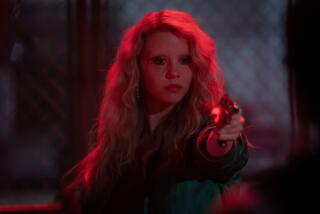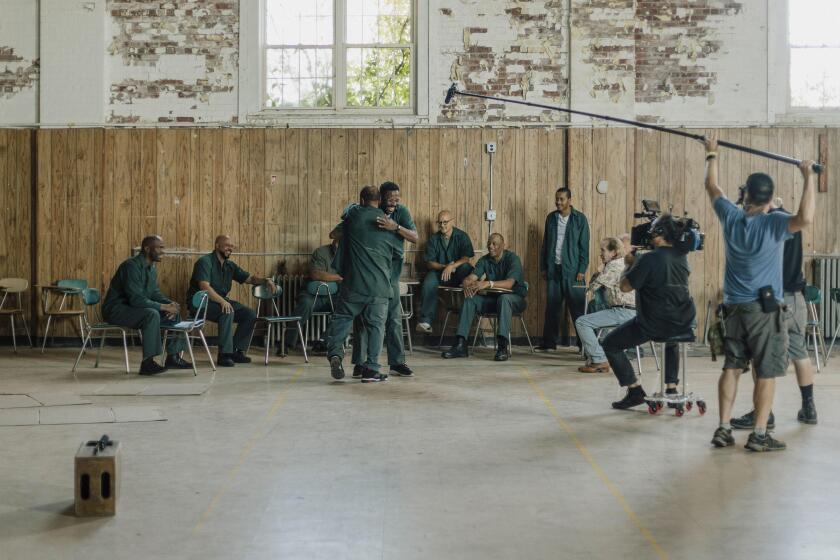‘The Girl on the Train’ review: Not even Emily Blunt’s rich acting can help this inept suburban potboiler

Featuring one of Emily Blunt’s showiest performances, “The Girl on the Train” aims to be a riveting tale of mystery and unreliable narration, but ends up “lurching and incoherent,” according to L.A. Times critic Justin Chang. Video by Jason H. Neube
From the moment she swept into “The Devil Wears Prada” wearing a bolero jacket and a withering sneer, the remarkable British actress Emily Blunt has made it clear that toughness becomes her. Since then she’s often dispensed with the designer fashions (and the sneer), but the toughness has only deepened, taking on richer shadings and emotional colorations.
It’s no surprise that she’s proved such a natural in the thriller genre: In her best recent movies, “Sicario” and “Edge of Tomorrow,” she played a woman cast into a labyrinth of treacherous secrets, forced to draw on her keen intelligence and physical acuity to fight her way out.
“The Girl on the Train,” a woozily inept suburban potboiler adapted from Paula Hawkins’ bestselling mystery novel, would love nothing more than to join that short list. And as Rachel Watson, a New York divorcee sinking into an alcoholic rage, Blunt certainly gives her showiest, most feverishly committed performance to date. Sipping vodka out of a water bottle and scribbling ominous sketches in her notebook, she stumbles through the movie looking strung-out and sleep-deprived — sometimes streaked with blood, invariably reeking of booze.
Her British accent the only surviving hint of the novel’s London setting, Rachel spends her days riding the Metro-North commuter train along the Hudson, which affords a perfect if fleeting view of the Westchester County home she once shared with her former husband, Tom (Justin Theroux). He now lives there with his new wife, a pretty blond named Anna (Rebecca Ferguson), and their baby daughter — the product of an affair that began while Tom and Rachel were still married.
Rachel lives for these painful glimpses of the catalog-perfect marital bliss that has been wrenched away from her, and she regards Anna with undisguised hatred and jealousy. But her envious gaze also drifts toward another blond in the neighborhood, Megan (Haley Bennett), who inhabits her own vision of domestic harmony with her husband, Scott (Luke Evans).
What Rachel doesn’t learn until later is that Megan works as a nanny for Anna’s daughter, completing a psychological triangle whose tidy self-containment comes perilously close to self-involvement.
See the most-read stories in Entertainment this hour »
As in the book, these various connections — of which none of the characters has more than partial knowledge — are unfolded through an intricate array of shifting perspectives and fractured timelines, designed to obscure as much as they reveal. But if Hawkins juggled these narrative strands with a dexterity that helped obscure the material’s thinness and lack of texture, the screenplay by Erin Cressida Wilson (“Secretary,” “Men, Women & Children”) leaps from one strand to another with none of the same finesse.
We spend some time getting to know Anna, whose smug delight in her situation turns to apprehension as she and Tom are flooded with text messages, phone calls and other apparent manifestations of Rachel’s obsessive behavior. Meanwhile, Megan, whose own troubled past comes to light in a few jarring flashbacks, nurses her wounds through a series of extramarital flings, including one with her conveniently studly therapist (Edgar Ramírez).
At the center of it all is Rachel, whose regular blackouts and hallucinations further smother the narrative in a thick haze of liquor and self-pity. When one character turns up missing, Rachel sets out, like Nancy Drew on a bender, to discover the awful truth, pushing her stalker-like tendencies into overdrive and triggering the suspicions of an investigating detective (a sharp Allison Janney).
With its themes of voyeurism and duplicity, its railway intrigue and its matching golden-haired vixens, “The Girl on the Train” is the kind of movie that often gets labeled Hitchcockian, never mind that the director, Tate Taylor, shows no particular mastery of suspense. Hawkins’ novel drew similarly unflattering “Gone Girl” comparisons when it was published last year, though both Gillian Flynn’s book and David Fincher’s razor-sharp movie adaptation possessed a surgically precise wit — a willingness to merge the preposterous and the satirical — that neither version of “The Girl on the Train” is equipped to match.
Rather than fully embracing the story’s undeniable trash appeal, this unaccountably serious-minded movie seems to have taken Rachel’s thumbnail — she is, objectively speaking, a confused, ranting, drunken mess — and attempted to spin it into an aesthetic conceit. Attempting to capture this woman’s perennially sozzled state in visual terms, Taylor lets the camera wobble to and fro, punctuates the story with jarring cuts to black, and resorts to slow-motion with amateurish abandon.
There are numerous ways for a film to convey radical subjectivity, substance abuse and memory loss without sacrificing narrative lucidity. (Examples as different as the “Bourne” thrillers, Christopher Nolan’s “Memento” and David Cronenberg’s “Spider” spring to mind.) But the incoherence of “The Girl on a Train” runs deeper than its visual sloppiness.
The movie lurches sweatily from one plot point to the next — coughing up a few stale red herrings one minute, taking a bleary-eyed stroll down memory lane the next, and delivering its grisly closing revelations with all the grace of a vagrant squatting to relieve herself on a subway platform.
All in all, it’s a bizarre change of pace for Taylor, who toyed around with chronology to much more stimulating effect in “Get On Up,” his underappreciated biopic of James Brown. The director remains best known for “The Help,” and if there’s a faint connection between that sentimental civil rights drama and this noirish psychothriller, it’s in the way both films strive — with varying degrees of success — for a complex, prismatic sense of female identity.
The other two women in “The Girl on the Train” can be interpreted as parallel emanations of Rachel’s rattled psyche; for all their differences, they’re all grappling with, and in some way rebelling against, the same crushing expectations of happy monogamy and motherhood. That’s the most generous explanation I can muster, anyway, for why Anna and Megan feel like cipher-like projections rather than actual characters, despite Ferguson’s and Bennett’s best efforts to breathe life into their tortured veins.
“What is it with you crazy women?” a man utters late in the proceedings, and as much as the film might seek to counter the misogyny of that insult, it can’t help but feel like a product of the same deep bewilderment. The empathy that Taylor summoned so effortlessly in his previous films feels strained and unpersuasive here, and moments that should be lacerating — more than one of them centered on the loss of a child — are overplayed to ghastly effect.
It doesn’t help that Blunt has been subjected to the sort of half-hearted movie-star deglam job that’s meant to signify seriousness in beauty-obsessed Hollywood. Yet her performance has its affecting moments nonetheless, straining and sometimes succeeding in turning all those flailing, dipsomaniacal mannerisms into genuine revelations of character. At every moment, you can’t wait to see what she’ll do next, by which I mean after this movie has ended.
------------
‘The Girl on the Train’
MPAA rating: R, for violence, sexual content, language and nudity
Running time: 1 hour, 52 minutes
Playing: In general release
Movie Trailers
More to Read
Only good movies
Get the Indie Focus newsletter, Mark Olsen's weekly guide to the world of cinema.
You may occasionally receive promotional content from the Los Angeles Times.











